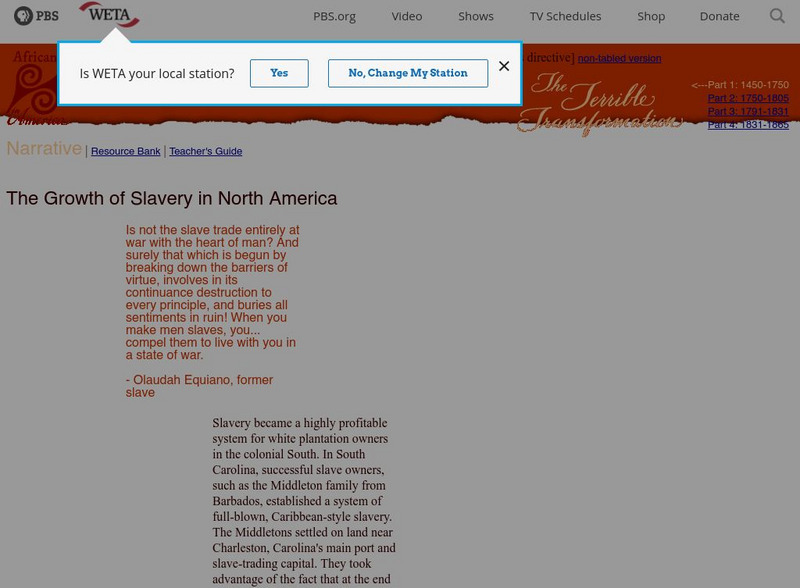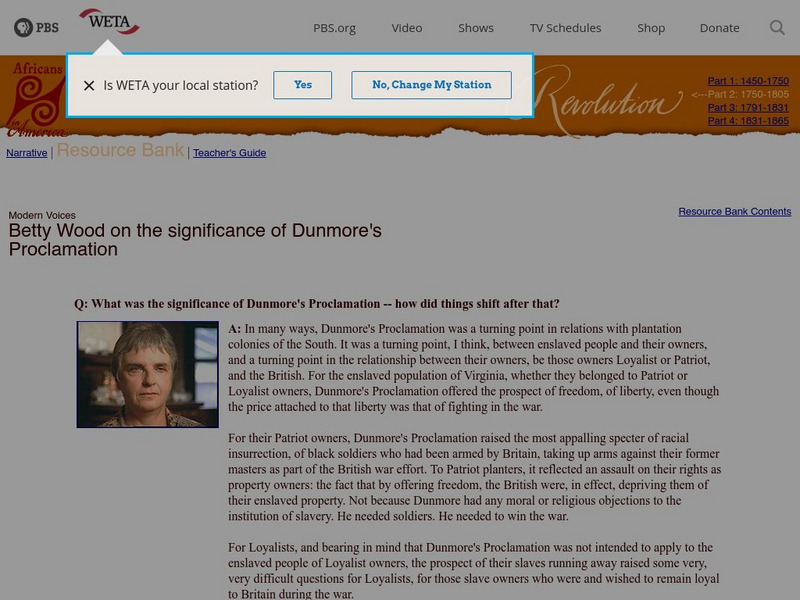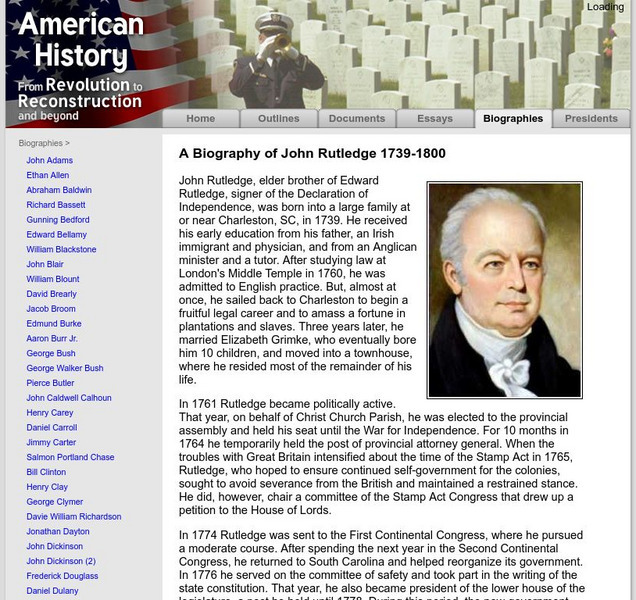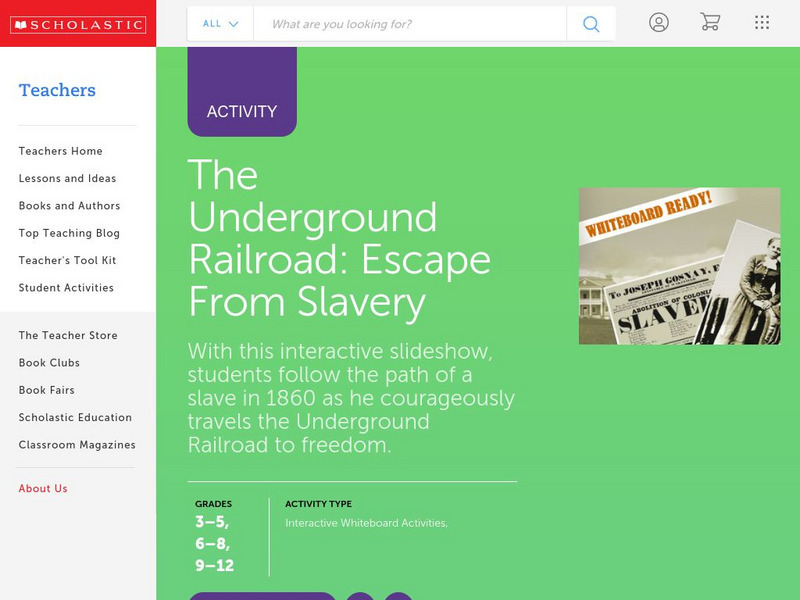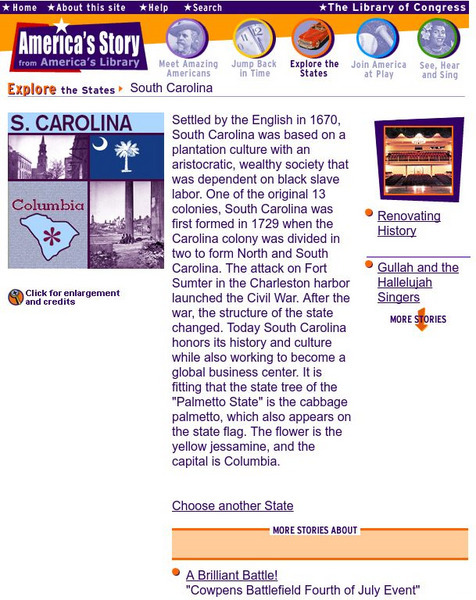PBS
Pbs: Cet: Africans in America: The Growth of Slavery in North America
Discusses the economics of slavery in South Carolina and its importance to the profitable growing of rice. It continues with ways the slaves were controlled and punished in South Carolina and Georgia. Click on Teacher's Guide for teacher...
US Department of State
Bureau of International Information Programs: History Outline: Sectionalism
Article reviews several conditions of American society that sowed the seeds of civil war, particularly slavery and sectional conflict.
National Humanities Center
National Humanities Center: Toolbox Library: Charles C. Jones, Triumph of Nationalism: America, 1815 1850
Plantation owner, Charles Colcock Jones, argues in two chapters from his book on promoting religious education for blacks that plantation owners have an obligation to offer religious instruction to slaves.
PBS
Africans in America: Revolution: Significance of Dunmore's Proclamation
A brief interview with Betty Wood, professor of history, on the significance of Dunmore's Proclamation to Loyalist plantation owners, Patriot plantation owners, and, in particular, the slaves themselves. From PBS.
National Humanities Center
National Humanities Center: Toolbox Library: Charles W. Chesnutt, Making of African American Identity: V. 2
A short story that explores the influence of the Southern plantation past on African American efforts to create new urban identities and the predicaments of post-emancipation life.
University of Groningen
American History: Biographies: William Blount 1749 1800
William Blount was the great-grandson of Thomas Blount, who came from England to Virginia soon after 1660 and settled on a North Carolina plantation. William, the eldest in a large family, was born in 1749 while his mother was visiting...
University of Groningen
American History: Biographies: John Rutledge 1739 1800
John Rutledge, elder brother of Edward Rutledge, signer of the Declaration of Independence, was born into a large family at or near Charleston, SC, in 1739. He received his early education from his father, an Irish immigrant and...
Smithsonian Institution
National Museum of American History: Slave Life and the Underground Railroad
A brief summary of the history of African American slavery and the Underground Railroad. Activities and books pertaining to slave life, plantations, and the Underground Railroad are suggested.
University of North Carolina
Unc: First Person Narratives of the American South
A unique collection of first-person accounts, this concentrates on all the populations of the South, such as ex-slaves, enlisted men, middle-class women, displaced plantation owners. The works are sorted by the author's name. To search...
Georgia Humanities Council and the University of Georgia Press.
New Georgia Encyclopedia: The Butler Family
An entry on the Butler family who owned large plantations on the Sea Islands. The "patriarch" was Pierce Butler who also served as a delegate to the Constitutional Convention.
Library of Congress
Loc: Women in the Civil War: Ladies, Contraband and Spies
This lesson uses primary sources - diaries, letters, and photographs - to explore the experiences of women in the Civil War. By looking at a series of document galleries, the perspectives of slave women, plantation mistresses, female...
Other
Monticello: A Day in the Life of Thomas Jefferson
Discover citizen and U.S. President Thomas Jefferson's daily routine, habits, inventions, and the home that he designed for his Virginia plantation.
US National Archives
Docsteach: Twelve Years a Slave
Students will examine several documents related to the life of Solomon Northup, whose life story is told in his autobiography Twelve Years a Slave: Narrative of Solomon Northup, a Citizen of New-York, Kidnapped in Washington City in 1841...
Scholastic
Scholastic: The Underground Railroad: Escape From Slavery
In this interactive unit students travel back to 1860 to follow a young slave as he flees a Kentucky plantation for Canada along the Underground Railroad. The interactive slideshow lets students read a short article at each stop. They...
Library of Congress
Loc: America's Story: South Carolina
Explore how South Carolina moved from a "plantation culture" in 1670 to a "growing research center and banking state" today. South Carolina played a major role in the Revolutionary War and the Civil War.
University of North Carolina
Documenting the American South: Thirty Years a Slave
From the extensive site, "Documenting the American South," read Louis Hughes' "Thirty Years a Slave: From Bondage to Freedom: The Institution of Slavery as Seen on the Plantation and in the Home of the Planter," which was originally...
University of Groningen
American History: Outlines: Movement South and Westward
Following Eli Whitney's invention in 1793 of the cotton gin -- a machine that separated raw cotton from seeds and other waste -- the cotton market boomed. Planters in the South bought land from small farmers who frequently moved farther...
Curated OER
National Park Service: Resource Study: Charles Pinckney National Historic Site [Pdf]
A scholarly publication which examines the archaeological findings of Snee Farm, the plantation and house owned by Charles Pinckney, a delegate to the Constitutional Convention from South Carolina. Click on "Table of Contents" to get a...
University of Groningen
American History: Outlines: Colonial Economy
Whatever early colonial prosperity there was resulted from trapping and trading in furs. In addition, the fishing industry was a primary source of wealth in Massachusetts. But throughout the colonies, people relied primarily on small...
University of Oregon
University of Oregon: Mapping History: Slave Crops in the American South: 1860
This very interesting map shows the crops grown by slaves on plantations in pre-Civil War South.
British Library
British Library: Discovering Literature: The Rise of Consumerism
With the increasing variety in clothes, food, and household items, shopping became an important cultural activity in the 18th century. This article describes buying and selling during this period and explains the connection between many...
A&E Television
History.com: How the South Helped Win the American Revolution
British commanders attempted to reverse their floundering fortunes by launching a campaign in the South. There the British would find not just crops such as tobacco, rice and indigo that were vital to their economy, but stronger Loyalist...
Digital History
Digital History: Slave Labor
Not all slaves worked in the fields. Read about the jobs of many skilled workers who were slaves in the South. Read also about the slaves who were field hands and find out about the harsh labor conditions they endured.
Georgetown University
Heath Online Instructor's Guide: William Bradford
Here, one can find helpful information on studying the works of American author William Bradford (1590-1657 CE). This website provides insight into specific themes and styles prevalent in Bradford's writing as well as suggestions for...
Other popular searches
- Slavery and Plantations
- Southern Plantations
- Plantations Ireland
- Coffee Plantations
- Southern Colony Plantations
- Iron Plantations
- Cotton Plantations
- Colonial Plantations
- Louisiana Plantations
- Hawaii Sugar Plantations
- Rice Plantations
- Maryland Plantations


